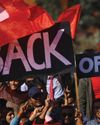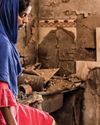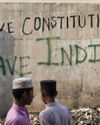How the termination of drought relief will affect communities in Lesotho

It was a windy June morning in Ha Lephalo, a tiny highland village overlooking rugged mountains and arid wasteland. Ha Lephalo is 50 kilometres north of Maseru, the capital of Lesotho—a small country landlocked by South Africa. That morning, I met the village chief, a 50-year-old woman named Itumeleng, who introduced herself to me as a biting wind swept across her wrinkled face. Lesotho’s steep, mountainous landscape—the country’s lowest point is at 1,400 metres above sea level—had earned it the epithet “Kingdom in the sky,” she said.
This geographical position has been both a blessing and a curse. Although its majestic highlands make the country a popular travel destination, reaching water sources is difficult because of its rugged terrain. The only source of water for Ha Lephalo had historically been a spring a two-hour trek away across slippery slopes. In 2015, even this source became tenuous because of a shortage of rainfall caused by El Niño—an irregular cycle of climate changes brought on by rising temperatures in the Pacific Ocean. El Niño triggered the worst drought to have hit Lesotho, and southern Africa, in the last 35 years.
Denne historien er fra January 2018-utgaven av The Caravan.
Start din 7-dagers gratis prøveperiode på Magzter GOLD for å få tilgang til tusenvis av utvalgte premiumhistorier og 9000+ magasiner og aviser.
Allerede abonnent ? Logg på
Denne historien er fra January 2018-utgaven av The Caravan.
Start din 7-dagers gratis prøveperiode på Magzter GOLD for å få tilgang til tusenvis av utvalgte premiumhistorier og 9000+ magasiner og aviser.
Allerede abonnent? Logg på

Mob Mentality
How the Modi government fuels a dangerous vigilantism

RIP TIDES
Shahidul Alam’s exploration of Bangladeshi photography and activism

Trickle-down Effect
Nepal–India tensions have advanced from the diplomatic level to the public sphere

Editor's Pick
ON 23 SEPTEMBER 1950, the diplomat Ralph Bunche, seen here addressing the 1965 Selma to Montgomery March, was awarded the Nobel Peace Prize. The first black Nobel laureate, Bunche was awarded the prize for his efforts in ending the 1948 Arab–Israeli War.

Shades of The Grey
A Pune bakery rejects the rigid binaries of everyday life / Gender

Scorched Hearths
A photographer-nurse recalls the Delhi violence

Licence to Kill
A photojournalist’s account of documenting the Delhi violence

CRIME AND PREJUDICE
The BJP and Delhi Police’s hand in the Delhi violence

Bled Dry
How India exploits health workers

The Bookshelf: The Man Who Learnt To Fly But Could Not Land
This 2013 novel, newly translated, follows the trajectory of its protagonist, KTN Kottoor.